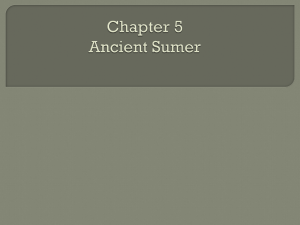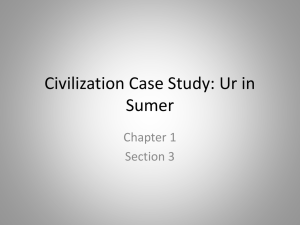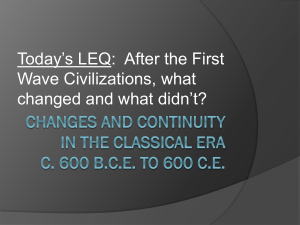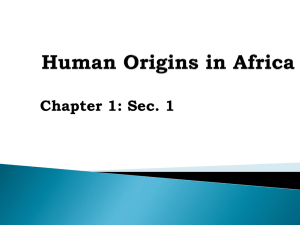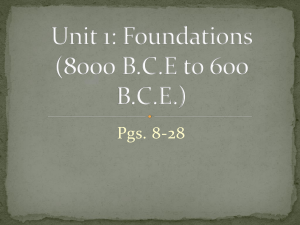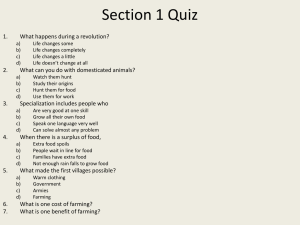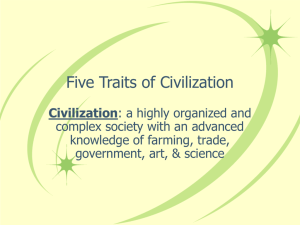Hunter-Gatherers shorter version
advertisement
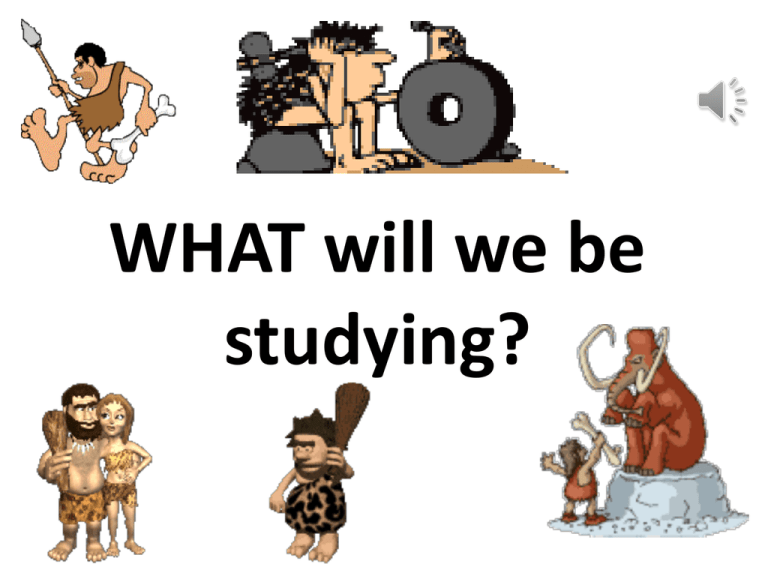
WHAT will we be studying? Standard 6-1: The student will demonstrate an understanding of the transition of humans from nomadic life to settled life in the cradles of civilization. 6.1.1 Analyze the hunter-gatherer communities in regard to their geographic, social, and cultural characteristics, including adaptation to the natural environment. ???? What is a nomad? someone who wanders looking for food & shelter What is a cradle of civilization? where civilization began Define hunter-gatherer communities and detail the characteristics that defined them. • hunter gatherers is the term used by anthropologists to describe a specific kind of lifestyle, that of all human beings until the invention of agriculture about 8000 years ago • hunter-gatherers hunt game and collect plant foods (called foraging) rather than grow or tend crops • hunter-gatherers tend to have non-hierarchical social structures • hunter-gatherers are nomadic • hunter gatherers live a subsistence lifestyle • they have little development of skills or specialized labor • they have low-population densities – usually in small tribes • the male puberty rite of passage often receives greater emphasis in hunter-gatherer societies than the other three ritual occasions celebrated in all human societies (birth ,marriage, and death). • hunter gatherers are sedentary when food is abundant hunter gatherers huntergatherers ???? What do anthropologists call humans who lived before the discovery of agriculture? hunter-gatherers Define foraging. collecting plants rather than growing crops When are huntergatherers nomadic & when are they sedentary? Hunter-gathers were nomads when there was no food & sedentary when food was abundant. Do hunter-gatherers have different jobs? Hunter-gathers did not have specialized jobs. What’s a hierarchy? a pyramid type structure based on rankings What is meant by “low-population density”? An example of lowpopulation density would be huntergatherers living in small tribes. Were hunter-gatherers hierarchical? Hunter-gathers were nonhierarchical. what it is So what? what it’s not context Were hunter-gatherers skilled or non-skilled? Hunter-gathers were non-skilled. We are going to go FORAGE! Describe how hunter-gatherers adapted to their natural environment (example – the use of simple tools to construct shelter, hunt, and make clothes) • Prehistoric hunter-gatherers, such as roving bands of Cro-Magnons, increased their food supply by inventing tools. • Hunters crafted special spears that enabled them to kill game at greater distances. • Digging sticks helped food gatherers pry plants loose at the roots. • Toward the end of the Ice Age, early Americans were producing hunting technologies that enabled them to kill mammoths and other large Ice Age mammals. • Hunting tools were made of bone, ivory, stone and antler, and used the wood, hide, and fiber of a variety of plants and animals. • One of the most commonly used hunting tools was the spear point. Crouched low to catch animals invented tools Herded buffalo over cliffs Digging sticks special spears Spear point How did early man adapt to his environment? Hunting tools were made of bone, ivory, stone and antler, and used the wood, hide, and fiber of a variety of plants and animals. How did early man adapt to his environment? ???? How did early man adapt to his environment? Hunter-gathers invented tools & special weapons. What was special about the spears of hunter-gatherers? Spears enabled them to kill animals from a greater distance. What kind of materials did hunter-gatherers use to make tools? They used ivory, stones, bones, plant roots & antlers. What kind of animal did hunter-gatherers kill that is extinct today? mammoths Describe how hunter-gatherers developed technological advances (example – stone tools, the use of art to express ideas) • Early modern humans used stone, bone, and wood to fashion more than 100 different tools. • Tool kits included knives to kill and butcher game, and fish hooks and harpoons to catch fish. • A chisel-like cutter was designed to make other tools. Cro-Magnons used bone needles to sew clothing made of animal hides. • Necklaces of seashells, lion teeth, and bear claws adorned both men and women. People ground mammoth tusks into polished beads. • They also carved small realistic sculptures of animals that inhabited their world. • Stone Age peoples on all continents created cave paintings. The bestknown of these are the paintings on the walls and ceilings of European caves, mainly in France and Spain. • Early artists drew lifelike images of wild animals In the famous cave of Les Trois-Frères, in Ariège, France, there is a rock painting, dated between 15,000 and 13,000 years ago, of a part-human, part-bison figure, variously described by scholars as a sorcerer, a magician, or a shaman, who appears to be performing music among wild animals. ???? What might a huntergatherer tool kit include? knives, fish hooks & harpoons List some ways huntergatherers were artistic? They made jewelry, carved statues & created cave paintings. What’s a shaman? sorcerer or magician How much can you tell your partner about prehistoric man in ONE MINUTE? Line up by height – count off by 5’s! You must build the tallest free-standing structure you can using only STRAWS & TAPE! On a colored index card, REFLECT on the activity you just completed! What are your thoughts? What did you like best? What did you find challenging? What would you do differently? Necessity is the Mother of Invention! Recognize the cultural & social distinctiveness of hunter-gatherer societies (examples – the use of rudimentary language to communicate, roles of men and women) Culture • common ways of dressing, similar hunting practices, favorite animals to eat. • Culture is the way of life of a group of people. • Culture includes common practices of a society, its shared understandings, and its social organization. • By overcoming individual differences, culture helps to unify the group. Common Practices • what people eat • clothing and adornment • sports • tools and technology • social customs • work Social Organization • family • class and caste structure • relationships between individual and community • government • economic system • view of authority Shared Understandings • language • symbols • religious beliefs • values • the arts • political beliefs what it’s not what it is culture So what? context Recognize the cultural & social distinctiveness of hunter-gatherer societies (examples – the use of rudimentary language to communicate, roles of men and women) • Homo erectus may have developed the beginnings of spoken language. • Language, like technology, probably gave Homo erectus greater control over the environment and boosted chances for survival. • The teamwork needed to plan hunts and cooperate in other tasks probably relied on language. • They lived in bands of 25 to 70 people. • The men almost certainly did the hunting. The women gathered fruits, berries, roots, and grasses. • Prior to spoken languages, members of a group communicated with one another by grunting or through simple noises, and hand gestures. • Spoken language allowed group members to exchange complex thoughts and ideas, and pass on their culture from one generation to the next. • Groups could discuss plans, teach techniques, explain how to track animals, or where to go to find water, as well as form religion and folklore. ???? Give examples of culture? Examples of culture include common ways of dressing & hunting, religious beliefs, customs & values What was the advantage of language? control over the environment, ergo better chance of survival What’s Homo erectus mean? Man stood up on two feet! Men were the _____; women were the ______. Men were the hunters; women were the gatherers. What made teamwork easier? the invention of language Before language how did humans communicate? grunting, noises & hand gestures (not THAT hand gesture!) What did spoken language allow huntergatherers to do? work in groups, plan, exchange ideas, develop religious values Describe how hunter-gatherers utilized discoveries during the Stone Age (example – fire) • According to anthropologists, Homo erectus was the first to use fire. • Fire provided warmth in cold climates, cooked food, and frightened away attacking animals. • The control of fire also probably helped Homo erectus settle new lands. Describe the impact of climate changes during the period and realize the value of migration as an enabling factor in societal development (example – the use of a land bridge to migrate into North America) • Scientists have two ideas about how could have people traveled beyond the ice sheets that covered Canada and blocked access to the United States. • One idea proposes that an ice free corridor opened in Canada as the glaciers melted. According to this theory, small trees began to appear in the ice-free corridor and, for the first time, wood became available for the warmth and cooking fires people needed to survive the journey. • The second idea suggests that people migrated down the coastline. Although the coastline was not completely ice-free, people may have used boats, and driftwood might have supplied the fires needed for survival. The Bering Land Bridge existed as a vast tundra plain connecting Asia and North America. As the world's glaciers and ice sheets melted over the following millenia, rising sea level flooded the land bridge — blocking migration routes for animals and humans. ???? Homo erectus was the first to do what? Use fire! What did the control of fire enable Homo erectus to do and WHY? Settle new lands – they could keep warm & cook. Lucy in the Sky with Diamonds video • 3,000,000 years old • first hominid • bones discovered in Ethiopia • Nicknamed “Lucy” after the Beatles song, Lucy in the Sky with Diamonds – Elton John later recorded the song too! what it is So what? what it’s not context Assessment – 6.1.1 • differentiate between the geographic, social, and cultural attributes of hunter-gatherer societies • distinguish between those characteristics of precivilization and civilizations • evaluate the development of hunter-gatherer community attributes in connection with the natural environment • utilize maps to explain and/or analyze migratory patterns of hunter-gatherers • Hunter-gatherer is an anthropological term used to describe human beings who obtain their food from the bounty of nature, hunting animals and gathering wild plants. • It is a subsistence lifestyle, practiced by all early human societies. • Such people are generally nomads, moving on as food supplies dwindle, but sedentary when in one place. • There is little development of skills or specialized labor beyond that required for hunting and gathering food. • Such societies generally remain small, consisting of several, often related, family units. what it is So what? what it’s not context Your assessment! Create a hunter-gatherer bio-poem! __________________________ (name) ___________, ____________, _________, ___________ (adjectives) lover of ___________, ___________ & ___________ who feels ___________, ____________ & _______________ who needs _______________________________ who gives _________________________ who fears ______________, _____________ & ___________ who would like to see ________________, _____________________ & __________________ resident of ________________________ __________________________ (name) NEW UNIT START HERE The Neolithic Revolution is the transition from a huntergatherer mode of subsistence to one based more upon the cultivation of crops, which first began in several centers dating from approximately 12,000-10,000 years ago. This transition also saw a change from a largely nomadic lifestyle to a more settled, agrarian-based one, with the onset of the domestication of plants and (later) animals. what it’s not what it is Neolithic revolution So what? context 6.1.2 Explain the emergence of agriculture and its effect on early human communities, including the impact of irrigation techniques and the domestication of plants and animals. Essential Knowledge – 6.1.2 • understand why agriculture developed and the effect this occurrence had on human society • explain how plant/animal domestication fostered agricultural development and the subsequent advent of semi-permanent human settlements – i.e. describe the role agriculture played in leading to humans to move from a nomadic lifestyle to the development of villages • understand the role of irrigation in this process and describe early irrigation techniques (examples – dams and canals • understand how the domestication of plants and animals eventually led to food surpluses Anthropologists argue that it was women who led the Neolithic Revolution and became history's first pioneers of agriculture • Instead of hunting and gathering food from the environments where they lived, humans learned to simply grow their own food. • Grains such as wheat, barley, rice, and corn were grown in different parts of the world. • Wild animals were also domesticated. Goats were utilized for their meat and milk, cattle, pigs, and chickens provided a steady source of food for the support of a group of humans. • With the advent of farming and domesticated animals to feed a society, life became much easier for early humans. As a result, many more humans survived the difficulties of life. The population quickly rose from around 2 million humans on the Earth, to more than 90 million. • Farming allowed people to build villages along rivers, or wherever the ground was fertile enough for crops to grow. Archeologists have found some villages that are believed to have been built more than 8,000 years ago. Some of these ancient villages, such as Jericho, still survive to this day. Understand why agriculture developed and the effect this occurrence had on human society • The shift from food-gathering to food-producing culture represents one of the great breakthroughs in history. • Change in climate was probably a key reason for the agricultural revolution. • Rising temperatures worldwide provided longer growing seasons and drier land for cultivating wild grasses. • A rich supply of grain helped support a small population boom. As populations slowly rose, hunter-gatherers felt pressure to find new food sources. Farming provided a steady source of food. Explain how plant/animal domestication fostered agricultural development and the subsequent advent of semi-permanent human settlements – i.e. describe the role agriculture played in leading to humans to move from a nomadic lifestyle to the development of villages • Some groups practiced slash-and-burn farming, in which they cut trees or grasses and burned them to clear a field. The ashes that remained fertilized the soil. Farmers planted crops for a year or two, then moved to another area of land. After several years, trees and grass grew back, and other farmers repeated the process of slashing and burning. • Hunters’ expert knowledge of wild animals likely played a key role in the domestication, or taming, of animals. • They tamed horses, dogs, goats, and pigs. Like farming, domestication of animals came slowly. Stone Age hunters may have driven herds of animals into rocky ravines to be slaughtered. It was then a small step to drive herds into human-made enclosures. From there, farmers could keep the animals as a constant source of food and gradually tame them. • Not only farmers domesticated animals. Pastoral nomads, or wandering herders, tended sheep, goats, camels, or other animals. These herders moved their animals to new pastures and watering places. • Domesticated animals became more common. The invention of new tools—hoes, sickles, and plow sticks—made the task of farming easier. • As the population of some early farming villages increased, social relationships became more complicated. The change from a nomadic hunting-gathering way of life to settled village life took a long time. Likewise, the change from village life to city life was a gradual process that spanned several generations. ???? What was the importance of learning to grow their own food? They could stay in one place. Why did human population increase? Development of agriculture & domestication increased the chance of survival. Give examples of domesticated animals. Goats, chickens, cattle or any animal that can be penned. Why were civilizations built along rivers? Land near rivers was more fertile & water was accessible. What is a pastoral nomad? someone who wanders & herds animals How long did the switch from huntergathering life to settled villages take? several generations Understand the role of irrigation in this process and describe early irrigation techniques (examples – dams and canals) • To cultivate more land and to produce extra crops, ancient people in larger villages built elaborate irrigation systems. • The resulting food surpluses freed some villagers to pursue other jobs and to develop skills besides farming. • Individuals who learned to become craftspeople created valuable new products, such as pottery, metal objects, and woven cloth. In turn, people who became traders profited from a broader range of goods to exchange— craftwork, grains, and many raw materials. • Two important inventions—the wheel and the sail—also enabled traders to move more goods over longer distances. Understand how the domestication of plants and animals eventually led to food surpluses As people gradually developed the technology to control their natural environment, they reaped larger harvests. Settlements with a plentiful supply of food could support larger populations. Assessment – 6.1.2 • explain the development of agriculture by summarizing how irrigation techniques changed the structure of early human communities • interpret the effects of domestication of plants and animals on agriculture and/or communities • hypothesize on the impact of domestication and/or surplus on human activity. ???? What did irrigation allow tribesmen to do? pursue other jobs – specialized work What inventions enabled humans to travel greater distances? wheel & the sail Cave Painting Activity NEW UNIT START HERE 6.1.3 Use maps, globes, and models in explaining the role of the natural environment in shaping early civilizations, including the role of the river systems of the Nile (Egyptian), Tigris-Euphrates (Sumerian, Babylonian, Phoenician), Huang He (Chinese), and Indus (Harappan); the relationship of landforms, climate, and natural resources to trade and other economic activities and trade; and the ways that different human communities adapted to the environment. Farming Develops in Many Places • Within a few thousand years, people in many other regions, especially in fertile river valleys, turned to farming. • In Africa the Nile River Valley developed into an important agricultural center for growing wheat, barley, and other crops. • In China About 8,000 years ago, farmers along the middle stretches of the Huang He (Yellow River) cultivated a grain called millet. • In Mexico and Central America farmers cultivated corn, beans, and squash. • In Peru farmers in the Central Andes were the first to grow tomatoes, sweet potatoes, and white potatoes. Four River Systems • Nile (Egyptian) • Tigris-Euphrates (Sumerian, Babylonian, Phoenician) • Huang He (Chinese) • Indus (Harappan) ???? In what continent was the Nile River Valley? AFRICA What’s another name for the Huang He river? Yellow River Where is the Yellow River (Huang He river)? CHINA Where was millet cultivated? CHINA Name the 4 river systems. Nile (Egyptian) Tigris-Euphrates (Sumerian, Babylonian, Phoenician) Huang He (Chinese) Indus (Harappan) Mesopotamia video Tigris – Euphrates • A desert climate dominates the landscape between the Persian Gulf and the Mediterranean Sea in Southwest Asia. Yet within this dry region lies an arc of land that provided some of the best farming in Southwest Asia • The region’s curved shape and the richness of its land led scholars to call it the Fertile Crescent. It includes the lands facing the Mediterranean Sea and a plain that became known as Mesopotamia. • The word in Greek means “land between the rivers.” Tigris & Euphrates • The rivers framing Mesopotamia are the Tigris and Euphrates. • They flow southeastward to the Persian Gulf. (See the map on page 30.) • The Tigris and Euphrates rivers flooded Mesopotamia at least once a year. As the floodwater receded, it left a thick bed of mud called silt. Farmers planted grain in this rich, new soil and irrigated the fields with river water. • The results were large quantities of wheat and barley at harvest time. The surpluses from their harvests allowed villages to grow. ???? Name the 4 river systems. Nile (Egyptian) Tigris-Euphrates (Sumerian, Babylonian, Phoenician) Huang He (Chinese) Indus (Harappan) Why was the Fertile Crescent given its name? Because of its shape & land near the Mediterranean that is good for farming What’s the Greek word for “land between two rivers? Mesopotamia Between what 2 rivers does Mesopotamia lie? Tigris & Euphrates Define silt. rich fertile soil What 2 grains were grown in Mesopotamia? wheat & barley What 2 grains were grown in Mesopotamia? wheat & barley Sumerians video 5 characteristics of civilizations • • • • • advanced cities, specialized workers complex institutions record keeping advanced technology Sumerians were one of first groups to form a civilization. Sumerians • They built cities that formed separate gov’ts – city states were like independent nations • Sumer’s earliest governments were controlled by the temple priests. The farmers believed that the success of their crops depended upon the blessings of the gods, and the priests acted as go-betweens with the gods. • A ziggurat was like a city hall & place of worship. From the ziggurat the priests managed the irrigation system. Priests demanded a portion of every farmer’s crop as taxes. Environmental Challenges & Solutions • unpredictable flooding combined with a period of little or no rain --- irrigation ditches • no natural barriers for protection --- mud brick city walls • limited natural resources – Sumerians traded grain, cloth & tools for raw materials like stone, wood & metal Sumerians • In time of war a leader was chosen - some military leaders became rulers who then passed down their power to their sons • By 2500 B.C., new cities were arising all over the Fertile Crescent, in what is now Syria, northern Iraq, and Turkey. • Sumerians exchanged products and ideas, such as living in cities, with neighboring cultures. This process in which a new idea or a product spreads from one culture to another is called cultural diffusion. Sumerians • They were polytheists • Believed gods were human-like but that humans were gods’ servants & needed to keep the gods happy • Social classes: – Kings, landholders, and some priests made up the highest level in Sumerian society. – Wealthy merchants ranked next. – The vast majority of ordinary Sumerian people worked with their hands in fields and workshops. – At the lowest level of Sumerian society were the slaves. Some slaves were foreigners who had been captured in war. Others were Sumerians who had been sold into slavery as children to pay the debts of their poor parents. Debt slaves could hope to eventually buy their freedom. • Social class affected the lives of both men and women. Sumerian women • Sumerian women could work as merchants, farmers, or artisans. • They could hold property in their own names. Women could also join the priesthood. • Some upper-class women did learn to read and write • Sumerian women had more rights than women in many later civilizations. Sumerian science & technology • Invented the wheel, the sail, and the plow and that they were among the first to use bronze • Arithmetic and geometry – In order to erect city walls and buildings, plan irrigation systems, and survey flooded fields, Sumerians needed arithmetic and geometry. They developed a number system in base 60, from which stem the modern units for measuring time (60 seconds = 1 minute) and the360 degrees of a circle. • Architectural innovations – Arches, columns, ramps, and the pyramid shaped the design of the ziggurat and permanently influenced Mesopotamian civilization. • Cuneiform – Sumerians created a system of writing. One of the first known maps was made on a clay tablet in about 2300 B.C. Other tablets contain some of the oldest written records of scientific investigations in the areas of astronomy, chemistry, and medicine. ???? What are the 5 characteristics of a civilization? advanced cities, specialized workers complex institutions record keeping advanced technology Who were the first people to form a civilization? Sumerians Define cultural diffusion. the sharing of ideas and customs The Fertile Crescent included what is now what countries? Syria, Iraq & Turkey Assessment – 6.1.3 • utilize maps to locate the river civilizations, interpret maps that identify the major river civilizations • infer the relationship between rivers and other landforms • detail trade patterns • ascertain the resources that would be available to a civilization • hypothesize about the continued development of these civilizations based on the interaction of key components including, but not limited to, location, availability of resources, and potential for trade • summarize the development of individual river valley civilizations or to compare civilizations – either as a whole or with specific components (examples – compare the Harappan civilization to the Sumerian [whole] or compare the natural resources among all these civilizations [specific components]) Essential Knowledge – 6.1.3 • explain the role that the natural environment had in shaping the location and development of early civilizations • recognize all of these early civilizations developed along major rivers • understand that these river valleys were ideal locations for civilizations to arise since they provided important resources (such was water, food, and fertile soil), natural trade/transportation routes, and, in some cases a natural defense against attacks • locate these early civilizations on maps and to associate the development of each civilization with a major river • understand that these rivers could be dangerous in times of flooding and that civilizations had to take measures to control flooding and/or lessen the severity of the impact & in spite of these attempts to control flooding, early civilizations often suffered devastating losses associated with this phenomenon Essential Knowledge – 6.1.3 • describe the common characteristics of river valley civilizations but also be familiar with some of the distinct characteristics of each river valley and its associated civilization • describe major physical features in addition to rivers that impacted civilizations – especially the nearby location of deserts which helped isolate and protect these civilizations as they developed • understand the type of products developed in each civilization and the trade which resulted from the production of these goods http://www.bbc.co. uk/sn/prehistoric_lif e/games/skeleton_ji gsaw/ • What are the differences between hunting and gathering and agriculture as modes of life? What is pastoralism? Consider the interactions of sedentary agriculturists with pastoral nomads. What are the possibilities for interaction? How would each group tend to view itself in contrast to the other? NEW UNIT START HERE 6.1.4 Compare the cultural, social, and political features and contributions of civilizations in the Tigris and Euphrates, Nile, Indus, and Huang He river valleys, including the evolution of language and writing systems, architecture, religious traditions and forms of social order, the division or specialization of labor, and the development of different forms of government. 6.1.5 Explain the role of economics in the development of early civilizations, including the significance and geography of trade networks and the agriculture techniques that allowed for an economic surplus and the emergence of city centers. Relax like a Hunter-gatherer! Nine Activities for Lifelong Relaxation • Walking with awareness – we were designed to walk with awareness: awareness of our bodies, of changes to our surroundings, of the ground we walk on, of the animals and people we pass. Humans survived because of this ability to be acutely aware! • Connecting to our body – yoga • Studying things that interest us • Listening to or playing music • Being in nature – animals/potted plants • Meditating - in meditation we make use of that part of the brain which also facilitates the freeze reaction-it is literally our escape from the danger of being over-stressed. • Art • Connecting to the divine or being spiritual • Being with friends


